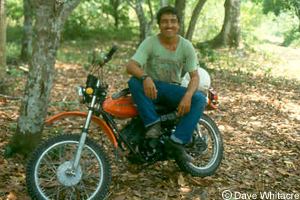|

|
Drying slash prior to burning.
|
MAYA PROJECT RESULTS: Hands-on Habitat Conservation
Efforts
2. Efforts to reduce wild fire in a slash-and-burn farming
landscape
A customary aspect of slash-and-burn farming is to burn felled forest biomass toward the end of the dry season, in preparation for planting. Sometimes such fires escape into neighboring mature or successional forest, causing
needless forest degradation, which is inimical to conservation goals. Such escape of fire is especially frequent during drought years.
|
 |
Chindo Garc�a
assisted farmers
in field burning.
|
In our project area we made an effort to decrease the escape of agricultural fire into mature forest. To this end, we devoted our agricultural extensionist, Chindo Garcia, to the additional task of working with farmers to promote
careful burning practices. Chindo also engaged in fire-suppression activities when fires did escape into forested areas.
For three years, Chindo worked with local farmers in villages just south of Tikal National Park. His main approach was simply to talk to farmers and encourage them to use caution when burning dried slash prior to planting crops.
He encouraged them to clear a ronda or fire break around fields prior to burning, and often helped them to do so. He would also help patrol fields after burning, extinguishing hot spots with a back-pack sprayer.
|

|
Making a fire-break through
second-growth bordering a milpa.
|
All-in-all, we found farmer response to Chindo's efforts to be modest. The physical work load on shifting agricultors is such that the additional labor involved in clearing a fire break is not welcome. Fortunately, farmers
are generally aware of burning methods that help decrease the spread of fire. They often begin slash ignition along the downwind side of the parcel, igniting the upwind side afterward. In this fashion, fuel along the downwind
side of the field is already burned before towering flames arrive, having crossed the entire field from the upwind side. This "black-lining" method helps prevent the escape of fire.
Wild Fires in Primary Forests of Protected Areas: A Serious
Problem Requiring International Attention
Recently a number of dry seasons have witnessed exceptionally dry conditions throughout much of Central America and southern Mexico, generally attributed to effects of El Ni�o-Southern Oscillation events. These severe dry seasons,
for example 1998, witnessed tremendous wild fires in many areas of primary forest in the region, mainly as a result of escaped agricultural fires. Within the Maya Biosphere Reserve, substantial percentages of certain "inviolate"
core areas burned in 1998. Fire apparently is not a natural occurrence in these forests--except perhaps at long intervals--and such forest fires present a grave threat to remaining forest in this region.
|

|
While fire-breaks are effective, making
them involves a good deal of labor.
|
We conclude that our own, small-scale efforts to prevent escape of fire in an agricultural landscape met with marginal success, and that escaped agricultural fire (and perhaps some intentionally set fires) represents a grave
threat to primary forests in this region. We feel that a serious, large-scale approach to both fire prevention and fire suppression is merited. Because of limited access over large wilderness areas here, it seems inescapable
that a serious capability for air-born fire suppression is required. No doubt international assistance would be paramount in creating the level of effort that is needed. We urge international lending and development agencies
to greatly increase financing and assistance for forest fire prevention and suppression throughout the forested tropics.
NEXT
26
|